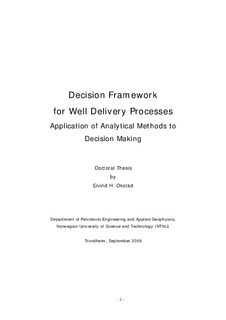| dc.contributor.author | Okstad, Eivind H. | nb_NO |
| dc.date.accessioned | 2014-12-19T12:14:01Z | |
| dc.date.available | 2014-12-19T12:14:01Z | |
| dc.date.created | 2007-04-25 | nb_NO |
| dc.date.issued | 2007 | nb_NO |
| dc.identifier | 122321 | nb_NO |
| dc.identifier.isbn | 978-82-471-0654-9 | nb_NO |
| dc.identifier.uri | http://hdl.handle.net/11250/239266 | |
| dc.description.abstract | A major portion of unproduced oil and gas resources are located in deep-water areas, often at sea level depths between 1500 and 3000 metres. Development of these fields with conventional technology necessitates increasing costs mainly due to the higher rig- and equipment specification needed. Conventional technology normally implies using a 21" marine riser and a 18 3/4" blowout preventer (BOP) that require heavy rig systems for handling and storage. Larger and more costly rigs in combination with longer time spent on the drilling and completion operations are the main contributions to the increasing cost. Thus, new solutions for cost-effective drilling and completion of deep-water wells have emerged during the recent years as alternatives to conventional technology. Among these new solutions are the big-bore well concepts that are focused on in this thesis.
On the other hand, uncertainty is usually connected to application of new technology. Uncertainty relates both to operational aspects, as well as to the expected production availability of finalized wells. Field development by using a big-bore well concept requires that the expected production rate relies on fewer wells compared to typical conventional well design. Thus, uncertainty needs to be considered carefully, as part of the decision basis.
Given the above challenges, decision makers are seeking appropriate methods and tools to support well engineering and the related decision processes. By combining methods within the area of risk analysis and decision analysis, the relevant properties and characteristics of alternative solutions are linked to the important requirements and decision criteria. Special attention is made to decision-making in project teams, or groups as result of a process. This kind of decision-making is interpreted as the decision process in the current thesis.
The main objective of the PhD project has been to develop a decision framework for deep-water well engineering adapted to the needs of a project team being the decision maker. The main intention is to improve confidence among such decision makers. Indirectly, this should stimulate increased utilization of new and alternative technologies for the drilling and completion of deep-water wells.
The framework includes a decision methodology for assessing the possibilities and limitations of technological options in a decision-making context. The body of the methodology contains the following basic steps: 1) Define the technical decision scope and structure of the well delivery process (WDP), 2) Select the basic well concept, and 3) Conduct the detailed design and approve it. In addition to the new decision methodology, a two-step procedure to guide industry implementation has been developed. This procedure involves the intended user from the early beginning. A case study describes an application of the decision methodology on a hypothetical drilling scenario. The case study also verifies the quality of the selected procedures and validates the methodology.
The combined risk assessment and decision analysis is new to well engineering. Instead of independent risk assessments, the current framework links such assessments directly to the decision processes of well engineering, i.e. to the value chain. It deals with the information of relevance, how assessments should be planned and accomplished, and finally, how the results should best be implemented.
The practical contribution of the framework and its methodology should be proactive support to engineering organizations in their decision processes. Both the quality and efficiency of ongoing decision processes are improved. Feedback from Shell mentioned the usefulness of applying the influence diagram method in the early identification phase of potential well concepts. Being part of the current methodology, this method provides linkages between the detailed factors at an operational level and the values aggregated at a higher managerial decision level. | nb_NO |
| dc.language | eng | nb_NO |
| dc.publisher | Fakultet for ingeniørvitenskap og teknologi | nb_NO |
| dc.relation.ispartofseries | Doktoravhandlinger ved NTNU, 1503-8181; 2007:30 | nb_NO |
| dc.title | Decision Framework for Well Delivery Processes - Application of Analytical Methods to Decision Making | nb_NO |
| dc.type | Doctoral thesis | nb_NO |
| dc.contributor.department | Norges teknisk-naturvitenskapelige universitet, Fakultet for ingeniørvitenskap og teknologi, Institutt for petroleumsteknologi og anvendt geofysikk | nb_NO |
| dc.description.degree | PhD i petroleumsteknologi og anvendt geofysikk | nb_NO |
| dc.description.degree | PhD in Petroleum Engineering and Applied Geophysics | en_GB |
